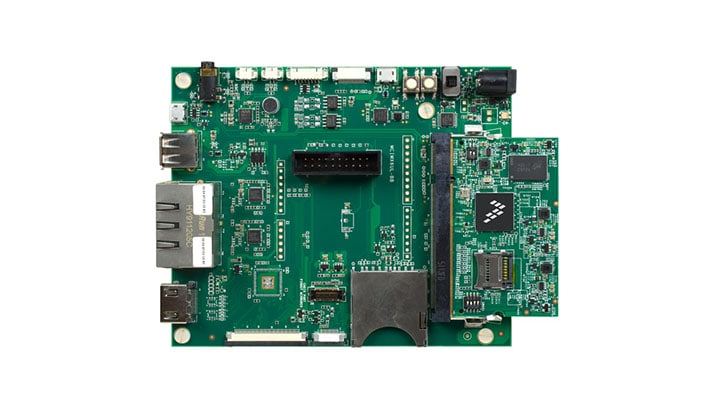Contributors
BG Networks - Cyber Security for the Internet of Things
Jasmin Infotech - Embedded solutions and services
Let us know if you need additional information for a manual integration and build.
Board description
The i.MX 6UltraLite processor is the first device in the i.MX product line to have a single Arm® Cortex®-A7 core operating at speeds of up to 696 MHz. This EVK enables an LCD display and audio playback as well as many connectivity options.
URL: i.MX6UltraLite Evaluation Kit - Technical and Functional Specifications
Wiki: i.MX 6 series
Test results
The Yocto Project releases in the table below have been tested by the Mender community. Please update it if you have tested this integration on other Yocto Project releases:
| Yocto Project | Build | Runtime |
|---|---|---|
| warrior (2.7) |  |
 |
Build Means that the Yocto Project build using this Mender integration completes without errors and outputs images.
Runtime Means that Mender has been verified to work on the board. For U-Boot-based boards, the integration checklist has been verified.
Getting started
Prerequisites
-
A supported Linux distribution and dependencies installed on your workstation/laptop as described in the Yocto Mega Manual
-
Google repo tool installed and in your
PATH.
Configuring the build
Setup Yocto environment
Create a directory for your mender-imx6ul setup to live in and clone the
meta information.
mkdir -p mender-imx6ul && cd mender-imx6ul
Initialize repo manifest:
# Downloading base manifest from NXP site
repo init -u https://source.codeaurora.org/external/imx/imx-manifest -b imx-linux-warrior -m imx-4.19.35-1.1.2.xml
# Adding demo manifest from meta-mender-community
wget --directory-prefix .repo/manifests https://raw.githubusercontent.com/mendersoftware/meta-mender-community/warrior/meta-mender-imx/scripts/imx-4.19.35-1.1.2_demo_mender.xml
# Initialising mender demo manifest
repo init -m imx-4.19.35-1.1.2_demo_mender.xml
Fetch layers in manifest:
repo sync
Setup build environment
Initialise the build environment:
- For first build:
MACHINE=imx6ulevk DISTRO=fslc-framebuffer source setup-mender-environment build
- For subsequent builds:
source setup-mender-environment build
Configure Mender server URL (optional)
This section is not required for a successful build but images that are generated by default are only suitable for usage with the Mender client in Standalone deployments, due to lack of server configuration.
You can edit the conf/local.conf file to provide your Mender server configuration, ensuring the generated images and Mender Artifacts are connecting to the Mender server that you are using. There should already be a commented section in the generated conf/local.conf file and you can simply uncomment the relevant configuration options and assign appropriate values to them.
Build for Hosted Mender:
# - log in to https://hosted.mender.io
# - click your email at the top right and then "My organization"
# - press the "COPY TO CLIPBOARD"
# - assign content of clipboard to MENDER_TENANT_TOKEN
#
MENDER_SERVER_URL = "https://hosted.mender.io"
MENDER_TENANT_TOKEN = "<copy token here>"
Build for Mender demo server:
# https://docs.mender.io/getting-started/create-a-test-environment
#
# Update IP address to match the machine running the Mender demo server
MENDER_DEMO_HOST_IP_ADDRESS = "192.168.0.100"
Building the image
You can now proceed with building an image:
bitbake core-image-base
Replace core-image-base with your desired image target.
Using the build output
After a successful build, the images and build artifacts are placed in tmp/deploy/images/imx6ulevk/.
The disk image (with.sdimg suffix) is used to provision the device storage for devices without Mender running already. Please proceed to the official documentation on provisioning a new device for steps to do this.
On the other hand, if you already have Mender running on your device and want to deploy a rootfs update using this build, you should use the Mender Artifact files, which have .mender suffix. You can either deploy this Artifact in managed mode with the Mender server as described in Deploy a system update demo or by using the Mender client only in Standalone deployments.
References
-
The official Mender documentation explains how Mender works. This is simply a board-specific complement to the official documentation.
-
meta-mender-imx6ul from bgnetworks - Complete mender integration for i.MX 6UL (fixed known issues)
-
i.MX6UltraLite Evaluation Kit - Overview
-
i.MX Repo Manifest README
Known issues
- Network not starting on boot, can be solved by Mender Tutorial - How to configure networking using systemd in Yocto Project
